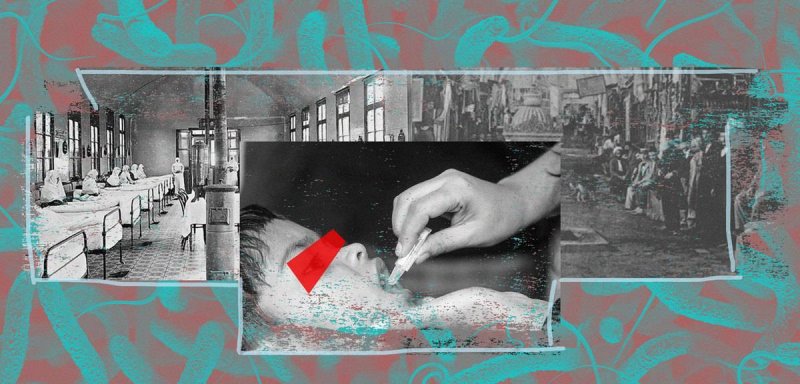"May you catch yellow air". This phrase is used by Lebanese people in their daily lives as a joke with their friends, or as a way of "cursing" their enemies, but many repeat it without knowing what this 'yellow air' is. It is the same cholera that the people of Lebanon are dreading today as it spreads throughout the country.
Speaking to Raseef22, microbiology and infectious diseases specialist and bacteriologist Dr. Jacques Mokhbat defines cholera as a disease caused by a bacterium called Vibrio Cholerae. This bacterium causes severe diarrhea within 24 hours after infection, and is sometimes accompanied by vomiting, leading to the dehydration of the body, and it's not necessary for a rise in body temperature to take place.
There is no doubt that the carrier of this germ spreads it in the sewage after it leaves his/her body, and somehow mixes with drinking water or the water used to irrigate crops. This then leads to the spread of cholera after a person drinks this water or eats the infected crops, according to Mokhbat.
The history of cholera
According to Dr. Imad Ghamloush, professor of history at the Lebanese University, studies indicate that the first outbreak of the epidemic took place in 1817, in Russia, after drinking water mixed with human waste. This caused the death of around one million people, and it soon moved on to the Asian continent, spreading in China and Indonesia and causing the death of more than 100,000 people by 1820.
The first appearance of the epidemic was in 1817, in Russia, after drinking water mixed with human waste, causing the death of around one million people
"During the same year, cholera spread in Nepal, and from there it reached India where it claimed tens of thousands of lives. There were British soldiers in India at the time, and ten thousand of them died. With the return of a number of soldiers to Britain, the epidemic spread throughout the kingdom, then all across Europe to countries like Spain, Germany, and France. The epidemic also reached Canada (Quebec and Montreal), and then entered New York in 1831." While speaking to Raseef22, Ghamloush continues, "The spread was rapid, so the disease spread from one person to another, and from city to city, despite the attempts to isolate the infected cities. They were trying to isolate them in all kinds of ways, but this did not prevent the spread of the disease. It kept re-emerging in waves every ten years in various countries across the world, where it claimed the lives of millions, due to the weakness of medicinal knowledge at the time, and the lack of understanding of the details of the disease, its spread, and the ways to treat it."
Lebanon and cholera
During the reign of the Ottoman Empire in 1828, the epidemic spread from India to Iran, and from there to the Eastern Mediterranean regions. It entered the sphere of influence of the Ottoman Sultanate, which was in control of the entire Arab region, including the Mount Lebanon Mutasarrifate (region), and began to decimate its population, killing tens of thousands in these lethal waves.
Also, due to the presence of French missionaries coming from Europe to the regions of the Middle East, especially Lebanon and Syria, cholera was transmitted through them. In 1831 the second epidemic arrived through pilgrims who transported it from Mecca to Lebanon, according to Ghamloush.
Cholera reappeared in the areas of the Ottoman Empire during the First World War that broke out in 1914, and spread widely in Lebanon starting 1916, claiming the lives of thousands, which led to waves of emigration to escape the deadly disease, as well as the forced conscription imposed by the Sultanate. It also reappeared in the forties and seventies of the last century.
In Lebanon's Mays al-Jabal region, there is a person named Issa Hijazi. He had thirteen sons who all died of cholera. Even those who buried their dead were dying the next day
The town of Mays al-Jabal (also Meiss El Jabal) in the Marjayoun district of southern Lebanon witnessed the death of dozens of its residents from cholera. The head of its municipality, Abdel Moneim Choucair, indicates to Raseef22 that in 1916, an infection called the 'yellow wind', the 'yellow air', or the Spanish fever spread — this is how the people used to call it. It swept through the area of Jabal Amel and led to the death of a very large number of residents, with the number of deaths reaching the dozens on a daily basis."
He adds, "In Mays al-Jabal, there is a person named Issa Hijazi. He had thirteen sons who all died of cholera. Even those who buried their dead were dying the next day, so people stopped burying the dead and the bodies were left in homes, for fear that the disease would be transmitted to them. Sheikh Musa Qabalan, who was the imam of the town, rejected this behavior and sought to uphold the burial of the dead."
Choucair points out that a quarter of the town's population died from the epidemic and half of them emigrated, thus leaving a quarter — no more than 700 people — in the town at the time, with the end of World War I.
Cholera is back
On the 28th of August this year, the emergence of cholera was announced in Syria, which prompted health and environmental activists to sound the alarm to warn of the possibility of the infection being transmitted to Lebanon, especially since there is active transit between the two countries, with the absence of any health measures at the crossings.
Cases of cholera have appeared in camps for displaced Syrians in northern Lebanon, and in Baalbek (east), and are increasing day by day
What many had been fearing, finally happened, as cholera cases appeared in camps for displaced Syrians in northern Lebanon, and in Baalbek (east), and began to increase day by day. The first death from the disease was recorded on the 12th of October, and the Ministry of Health held a series of meetings with international organizations to get ahead of the disease and limit its spread. A ministerial committee was formed to combat the spread of cholera, headed by Prime Minister Najib Mikati, and including the ministers of health, interior, environment, agriculture, industry, and energy. The committee developed a plan to combat cholera in cooperation with each other and with the international community.
The head of the Preventive Medicine Department at the Lebanese Ministry of Health, Dr. Atkeh Berri, speaks to Raseef22 about the high improbability of limiting the spread of the disease in light of an improper infrastructure, as this disease is linked to feces and the mouth. She notes that the meeting held at the Ministry of Health with teams, international organizations, and relevant ministries focused on the need for concerted efforts to secure safe water for people in the first place.
Limiting the spread
As for treating the infected, according to doctors, the infected person is compensated for the loss of water and minerals in his/her body through IV and drinking water, while following preventive measures such as allocating a separate toilet to the infected, to reduce the transmission of infection. According to doctor Mokhbat, the patient is given an antibiotic to prevent the transmission of bacteria out of the body, and avoid its transmission to nature.
According to Berri, the ministry, in cooperation with the World Health Organization, has secured chlorine tablets used for sterilization, and people are being informed about how to deal with cholera at home, so that they do not have to go to the hospital, as 80% of cases can be treated at home through drinking plenty of water and hanging an IV serum at the beginning. But if it is not treated from the beginning, the condition worsens, and the body loses large amounts of water, minerals, and salts, and the infected person will be in urgent need of hospitalization, possibly in intensive care, and sometimes the disease may lead to death.
Awareness and treatment
It is important to inform the local community about the nature of the disease, how it is transmitted, the ways to prevent it, and how to treat the infected, in addition to the protocols for treatment inside one's home and dealing with the infected. This is why the Ministry of Public Health distributed leaflets, spread awareness videos, and set up a hotline to call (1787) to get more information on the cholera disease.
A quarter of the population of Lebanon's Mays al-Jabal region died from the epidemic, and half of them emigrated to escape, thus leaving a quarter — no more than 700 people — in the town at the time, with the end of World War I.
There is a call to address sewage problems, repair malfunctions in the wastewater networks to prevent them from mixing with drinking and service water, and restart wastewater treatment plants, all in order to reduce the spread of bacteria. There should also be stricter control over agricultural areas to prevent the irrigation of crops with contaminated water, and keep pollutants and polluters away from water sources. Otherwise the treatment will be incomplete, since the causes must be addressed first and foremost, rather than the result.
The 'yellow air' that the cholera disease has been called — because people in the past thought that it was the result of bad air becoming contaminated with germs — has become the subject of talk among the Lebanese people for generations, so much so that they used it in phrases to curse their enemies, or those who have offended them, because they know of how lethal it is. This is a reality that we are living in today — as if we have been suddenly thrust back into those past eras — as a result of the neglect of humans and the state at the same time.
Raseef22 is a not for profit entity. Our focus is on quality journalism. Every contribution to the NasRaseef membership goes directly towards journalism production. We stand independent, not accepting corporate sponsorships, sponsored content or political funding.
Support our mission to keep Raseef22 available to all readers by clicking here!
Interested in writing with us? Check our pitch process here!









